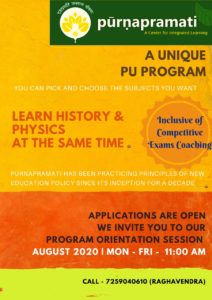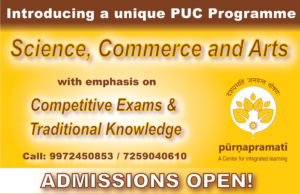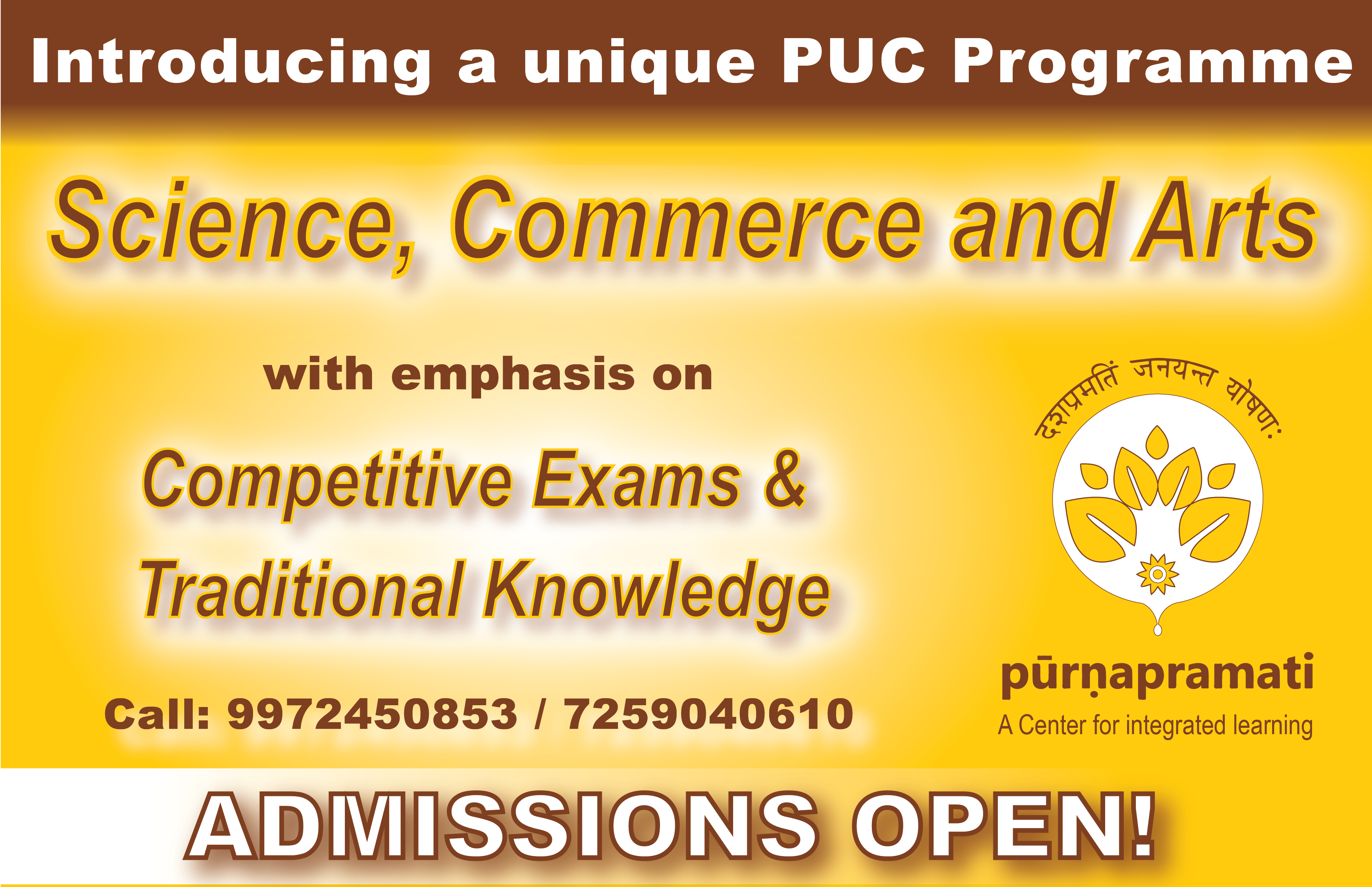Recent Updates
Subscribe
Excellence – A Guiding Principle
Krishna Kadiri
Purnapramati Team
Excellence means different things to different people, and in different contexts. Let’s start with a popular anecdote on Excellence :
A German once visited a temple under construction where he saw a sculptor making an idol of God. Suddenly he noticed a similar idol lying nearby. Surprised, he asked the sculptor, “Do you need two
statues of the same idol?” “No,” said the sculptor without looking up, “We need only one, but the first one got damaged at the last stage.” The gentleman examined the idol and found no apparent damage. “Where is the damage?” he asked. “There is a scratch on the nose of the idol.” said the sculptor, still busy with his work. “Where are you going to install the idol?” The sculptor replied that it would be installed on a pillar twenty feet high. “If the idol is that far, who is going to know that there is a scratch on the nose?” the gentleman asked. The sculptor stopped his work, looked up at the gentleman, smiled and said, “I will know it.”
We usually use these anecdotes to tell others about excellence, rather than imbibe it as a value to pursue. Given the rush of our lives with little time for most things, and such a populous country with numerous options – be it for anything; education, food, entertainment etc. – it is not surprising that excellence takes a back seat and whatever serves the basic purpose gets accepted. For example, a public transport bus that carries people from one point to another is neither rejected, nor is there a demand for public transport designed for a comfortable commute. This excessive predominance or focus of ‘whatever works’ has pushed the drive for excellence to the backseat. Even those, who pursue excellence, are lead to frustration of there not being a direct reward. And some day, that drive to excellence will die its own natural death, if not used or nourished.
However, despite there no being direct reward, the pursuit of excellence is a very satisfying one. It is a never-ending journey. For one, excellence is not about competition with others. It is one’s wish to excel oneself. This pursuit does not tire oneself because a human exhilarates, by his very nature, when he sees a positive change in himself. Most importantly, this pursuit helps one not get distracted by other ‘rewards’ and stay focused on oneself.
And such a pursuit cannot begin without a dream of what excellence means in that context. So, here, I narrate our dream of excellence:
1. Integrated Learning: That is Purnapramati’s most fundamental promise. The basic purpose would be served by the additional classical subjects (at various levels) and the methodology adopted. However, if additional means are devised to ensure that the child is not dogmatic about any system of knowledge but is neither indecisive, that would be a step towards excellence. Integrated Learning should open up his mind to different approaches to a problem, should make him understand different facets of the problem and not just the popular one. For example, is the problem of alternate energy sources related to consumerism, which itself is related to one-life belief? If the learning is really holistic and presented in the way it should be (rather than dogmatic axioms), the child must not think there are two different / contrasting streams of education. For the child, there is no integrated learning. There is just learning.
The next measure would be to get parents, grandparents, friends, cousins, teachers interested in Integrated Learning. After all, it is important to everybody’s life! Most parents and friends of Purnapramati are interested in this idea because ‘there is a fear of losing our culture and getting westernized’. While that is a good motivation, one must still ask – why this loss of culture? A little introspection gets to the root of the problem i.e. oneself. And to those people, who wish to correct the offset (instead of just blaming the earlier generations), Purnapramati must become relevant.
The next level would be when society and other institutions recognize the value for such integrated education and become good competition to Purnapramati! And the school should propagate the idea of integrated learning and enable other schools for providing the same in as remote areas as possible.
2. Svadharma: Within Purnapramati, the word Svadharma refers to natural propensities and intrinsic talent of an individual. We recognize that these are given by God, and he gives them in good measure because such are needed for the purpose of that life. Identifying those starts with teachers and staff observing the child in a qualitative manner, as is already prevalent at the school. The teachers identify what is the child good at, what are his ways of learning etc. That is a good but first step. It is limited to the subjects taught at school. However Svadharma as a concept is much deeper and requires greater involvement and exposure of the teacher. Essentially the child must realize on his own (without any goading), what he is good at (at a suitable age), where he excels, where his interests lie etc. And the child must be able to act upon it, to find his own calling.
3. Cultural Values over culture: While the basic curriculum will retain certain cultural aspects in the child, it is necessary to go beyond that. The child must be able to understand the philosophy behind the culture, the values guiding such culture as much as the culture itself. For example, instructing the child to bow to elders is teaching culture; however teaching the child that bowing down is a gesture to acknowledge greater experience, to acknowledge one’s gratitude, and to respect the forms of Supreme Being present in such elders. The culture itself is transient; the values are and should be more persistent.
4. Teacher vs. Guru: This is for our teachers. Teacher teaches, Guru guides. Our tradition holds a Guru as a reflection of the Supreme Being, for an aspirant. Similarly, our children should develop that kind of relation, by themselves, with their gurus. For this to happen, the teacher must understand the child more deeply than is possible within the bounds of a classroom. Sometimes the guru must override the parents!
Of course, Purnapramati has steps to go before the team (i.e. the staff, teachers, children) feel that they have reached the first rung of excellence. While there are many intermediate or more specific steps that have to be thought of, I have a last point to make on this pursuit of excellence. In the end, one must remember that this pursuit itself is like a sacrificial offering to the Lord. It must be done with as much passion and dispassion, with a sense of devotion to Lord and to the purpose of this organization. This truly will make one a ‘yogi’ – a person connected with God. Can we offer anything but the excellent to the Lord?
Source: ಊರ್ಧ್ವಮೂಲ Purnapramati Souvenir 2012















December 31st, 2013 at 2:32 pm
Striving towards excellence – An excellent principle.
Kudos to you and the entire Pramati team in bringing this Integrated education concept.
This is also to share a few thoughts and sign up to be a volunteer.
I was watching the 2012 Seminar videos.
Appreciations – Great speakers, great content
Areas of improvement –
– Sad to see only a handful of interested audience
– Few downloads
– How can we take these great messages to a wider audience?
– Can we have transcripts of the sessions?
Do let me know how I can join hands with Pramati as a volunteer.
Thanks…Jayashree